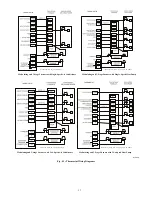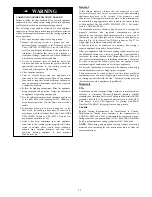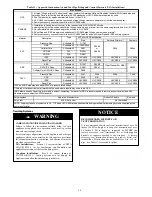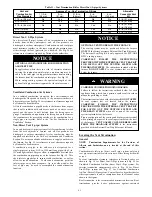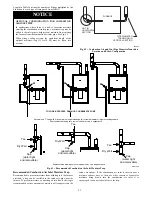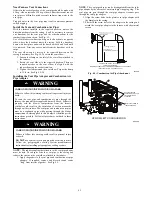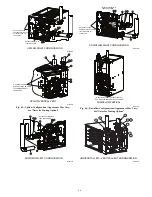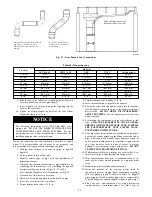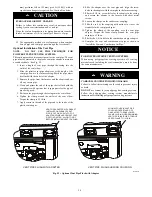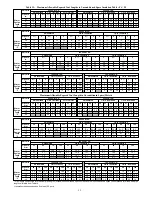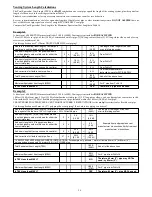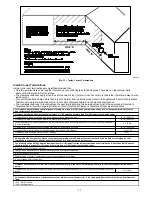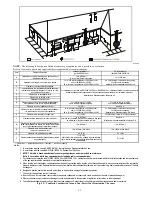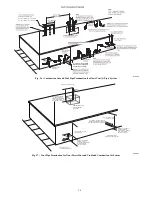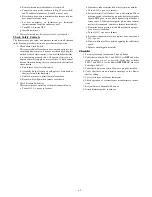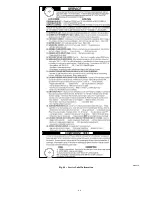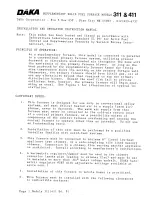
51
Installing the Vent Termination
Roof Terminations
A roof termination of any type will require a 4-in. (102 mm)
flashing for a 2 in. (50 mm ND) concentric vent or a 5--in. diameter
(127 mm) flashing for a 3-in. (80 mm ND) concentric vent kit. For
two-pipe or single pipe vent systems, a flashing for each pipe of the
required diameter will be necessary.
It is recommended that the flashing be installed by a roofer or
competent professional prior to installing the concentric vent. The
terminations can be installed on a flat or pitched roof.
Concentric Vent
Single or multiple concentric vent must be installed as shown in
Fig. 56. Maintain the required separation distance between vents
or pairs of vents as shown in Fig. 56 and all clearance shown in
Fig. 54.
NOTE
: Follow the instructions of the vent terminal manufacturer.
These instructions are provided as a reference, only.
Cut one 4--in. (102 mm) diameter hole for 2--in. (50 mm ND) kit,
or one 5--in. (127 mm) diameter hole for 3--in. (80 mm ND) kit in
the desired location.
Loosely assemble concentric vent/combustion air termination
components together using instructions in kit.
Slide assembled kit with rain shield
REMOVED
through hole in
wall or roof flashing.
NOTE
: Do not allow insulation or other materials to accumulate
inside of pipe assembly when installing it through hole.
Disassemble loose pipe fittings. Clean and cement using same
procedures as used for system piping.
DO NOT CEMENT
POLYPROPYLENE FITTINGS.
Two--Pipe and Single--Pipe Terminations
Single and two pipe vent must be installed as shown in Fig. 56 and
57. Maintain the required separation distance between vents or
pairs of vents as shown in Fig. 56 and 57 and all clearance shown
in Fig. 54 and 55 .
RECOMMENDED SUPPORT FOR VENT
TERMINATIONS
It is recommended that rooftop vent terminations in excess of
36 inches (1 M) in vertical length be supported by
EITHER
the Direct Vent Termination Kit shown in Table 13 or by
field--supplied brackets or supports fastened to the structure.
NOTICE
Cut the required number of holes in the roof or sidewall for vent
and (when used) combustion air pipes. Sidewall holes for two-pipe
vent terminations should be side-by-side, allowing space between
the pipes for the elbows to fit on the pipes.
Holes in the roof for direct--vent two--pipe terminations should be
spaced no more than 18 in. (457 mm) apart to help avoid vent gas
recirculation into combustion air intake.
Termination elbows will be installed after the vent and (if used)
combustion air pipe is installed.
Sidewall Terminations
Concentric Vent
NOTE
: Follow the instructions of the vent terminal manufacturer.
These instructions are provided as a reference only.
Determine an appropriate location for termination kit using the
guidelines provided in section “Locating The Vent Termination” in
this instruction.
1. Cut one 4--in. diameter hole for 2--in. kit, or one 5--in. diam-
eter hole for 3--in. kit.
2. Loosely assemble concentric vent/combustion air termina-
tion components together using instructions in kit.
3. Slide assembled kit with rain shield REMOVED through
hole.
NOTE
: Do not allow insulation or other materials to accumulate
inside of pipe assembly when installing it through hole.
4. Locate assembly through sidewall with rain shield posi-
tioned no more than 1--in. (25 mm) from wall as shown in
Fig. 56.
5. Disassemble loose pipe fittings. Clean and cement using
same procedures as used for system piping.
DO NOT CE-
MENT POLYPROPYLENE FITTINGS.
2-Pipe and 1-Pipe Vent Termination
NOTE
: Follow the instructions of the vent terminal manufacturer.
These instructions are provided as a reference, only.
RECOMMENDED SUPPORT FOR VENT
TERMINATIONS
It is recommended that sidewall vent terminations in excess of
24 inches (.6 M) in vertical length be supported by
EITHER
the Direct Vent Termination Kit shown in Table 13 or by
field--supplied brackets or supports fastened to the structure.
NOTICE
Determine an appropriate location for termination kit using the
guidelines provided in section “Locating The Vent Termination” in
this instruction.
1. Cut two holes, one for each pipe, of appropriate size for
pipe size being used.
2. Loosely install elbow in bracket (if used) and place assem-
bly on combustion--air pipe.
3. Install bracket as shown in Fig. 56 and 58.
NOTE
: For applications using vent pipe option indicated by
dashed lines in Fig. 56 and 57, rotate vent elbow 90
_
from
position.
4. Disassemble loose pipe fittings. Clean and cement using
same procedures as used for system piping.
DO NOT CE-
MENT POLYPROPYLENE FITTINGS.
(Direct Vent / 2-Pipe System ONLY)
When two or more furnaces are vented near each other, two vent
terminations may be installed as shown in Fig. 56, but next vent
termination, or pair of vent terminations, must be at least 36 in.
(914 mm) away from the first two terminations. It is important that
vent terminations be made as shown in Fig. 56 to avoid
recirculation of vent gases.
Inducer Outlet Restrictor
To improve efficiency and operation of 40K, 60K or 100K BTUH
input models on very short vent systems, an inducer outlet
restrictor is required to be installed on the outlet of the inducer
assembly. The outlet restrictor is shown in the footnote of Table 16
--Maximum Equivalent Vent Length. The outlet restrictor for 40K
models is shipped in the loose parts bag. See Table 16 for usage,
part numbers and sourcing of 60K and 100K inducer outlet
restrictors.
To determine if the outlet restrictor is required, see Table 16.
Failure to use an outlet restrictor on the 40K model when
required may result in flame disturbance or flame sense
lockout.
To install the outlet restrictor:
1. Remove the vent elbow from the inducer outlet.
2. Align the lock tabs on the outlet restrictor with the slots on
inside outlet of the inducer assembly.
3. Snap the outlet restrictor in place.
4. Re-install the vent elbow.
5. Torque vent elbow clamp 15-lb--in.

